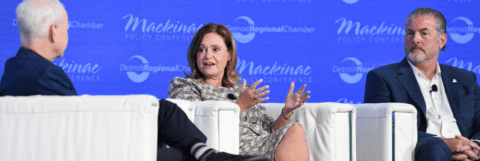Key Takeaways:
- In addition to charging ports, consumers are concerned with range anxiety and affordability.
- While electrification is here and industry must “adapt or die,” ICE isn’t going away just yet.
- A unique benefit of the continuing EV transition is bidirectional charging.
As we are seeing the transition from internal combustion engine (ICE) vehicles to electric vehicles (EV), industry and consumers are wondering if Michigan is prepared to maintain its global automotive leadership as it enters the electrification era. During the 2023 Mackinac Policy Conference, the following panelists discussed Michigan’s adoption, OEM investments, and more:
- Linda Apsey, President and Chief Executive Officer, ITC Holdings
- David C. Dauch, Chairman of the Board and Chief Executive Officer, AAM
- Mujeeb Ijaz, Founder and Chief Executive Officer, Our Next Energy
- With moderator, John McElroy, Host, Autoline
When asked if the energy grid is ready and capable of handling the transition to EV, Apsey said the industry is going through a massive transformation as it moves away from fossil fuels and builds renewables. At the same time, it is shifting more and more of its focus on building reliability and resiliency. She said the industry expects an 8-13% increase in demand from EVs alone by 2030.
“In our business, that’s huge and that’s significant,” she emphasized. From a transmission perspective, the grid will eventually reach a tipping point, which will demand a local focus.
On the role that a traditional ICE manufacturer like AAM will play in this transition, Dauch was confident that while electrification is here and industry must “adapt or die,” ICE isn’t going away just yet. Further validating his claim is AAM’s recent receipt of a large contract with Stellantis, which proves their technology will remain relevant moving forward.
In response to the consumer concern surrounding availability of charging ports, Ijaz sees this as an opportunity for batteries to help level the demand as well as create supply. His company will do this by expanding beyond the use of batteries just for vehicles, toward using batteries as a means of energy storage for businesses. ONE accomplishes this by using an iron phosphate chemistry that can be used in both automotive and for the grid. Having a factory that can produce products for both, “helps with costs, improves efficiency, and gets us into multiple markets.” The industry will also need to address charging infrastructure deserts in rural areas and long waits to charge in cities.
Dauch added that in addition to charging ports, consumers are concerned with range anxiety and affordability. At minimum, people need their EVs to be able to travel at least 300 miles per charge to feel comfortable.
“When it’s all said and done, the whole thing is going to come down to affordability,” and at an average price of $66,000, that is still out of reach for most Americans. Ijaz added that although the average consumer isn’t using hundreds of miles of charge every day, that occasional occurrence is preventing them from transitioning away from ICE. EVs will need to have at least 600 miles of range to overcome this psychological barrier.
A unique benefit of the continuing EV transition that can be leveraged to change consumer mindset is bidirectional charging. EV owners can use their car batteries to charge other things as well as sell the energy for extra income.
President Biden wants to see 50% EV adoption by 2030, but Dauch and Apsey predict that the U.S. will hit capacity at 30% until infrastructure development can catch up. Optimistically, Ijaz affirmed Biden’s goal, citing the unprecedented investment in energy storage, especially from the federal government.
RELATED: Talent, BEVS, & Startups: Once-in-a-Century Opportunity for Michigan
This Mackinac Policy Conference session was sponsored by Michigan State University.

